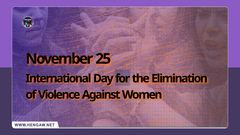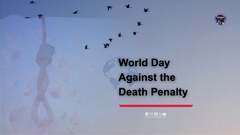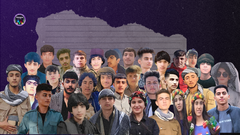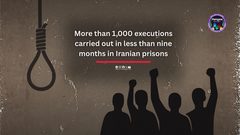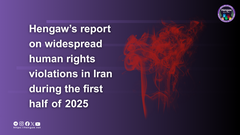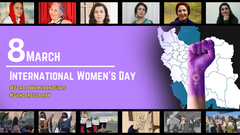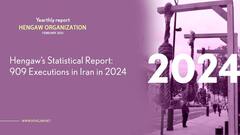Hengaw's Comprehensive Report on Human Rights in Iran for the Year 2023
Hengaw Organization for Human Rights will release its statistical report highlighting the concerning sta

Hengaw: Sunday, December 31, 2023
Hengaw Organization for Human Rights will release its statistical report highlighting the concerning state of human rights and the escalating violation of fundamental rights in Iran.
According to data meticulously documented by the Statistics and Documentation Center of Hengaw Organization for Human Rights, the year 2023 witnessed distressing figures. Notably, 823 death row prisoners and 333 Kolbars suffered fatalities or injuries, while 27 individuals fell victim to landmines and explosives. Additionally, 34 prisoners lost their lives in Iranian prisons, and 2,342 individuals with verified identities were arrested. Disturbingly, 21 political activists and protesters received death sentences, and 547 activists faced a cumulative imprisonment term of 2,944 years and 8 months, along with 94 years of suspended imprisonment and 2,547 floggings. Tragically, at least 121 women were killed by individuals closely associated with their families.
The statistics compiled by Hengaw Organization for Human Rights underscore the critical human rights situation in Iran. The widespread execution of prisoners, arbitrary arrests, and heightened violence against vulnerable groups, including Kolbars and civil activists, paint a shocking picture of pervasive human rights violations. Moreover, instances of national and religious discrimination, along with the targeting of political and civil activists, reveal a troubling absence of justice and freedom of expression. This situation necessitates increased attention and pressure from the international community and human rights defender institutions to advocate for fundamental reforms, aligning with the doctrine of the "responsibility to protect" the rights of Iranian citizens.
The Islamic Republic's policy toward women reflects a systematic violation of their rights, extending to sexual and gender minorities. This devaluation is evident not only in the political and ruling spheres but also in the social context. The ease with which women are targeted, coupled with the cost-effective nature of these actions, underscores a disturbing trend. The Islamic Republic's government itself perpetrates the murder of women and creates formidable barriers for women working in this field. Consequently, the actual number of femicides exceeds what is reported in the news and media. Hengaw cautions against normalizing the killing of women in society, emphasizing the importance of acknowledging the rampant arrests and torture of activists working to expose organized sexual and gender-based violence. Furthermore, Hengaw highlights the alarming absence of documented statistics on political and social violence against sexual and gender minorities in Iran, emphasizing the need for immediate attention and intervention.
In the upcoming days, detailed thematic reports on the following topics will be published separately:
Execution of 823 Prisoners in Iran during 2023
The Statistics and Documentation Center of Hengaw Organization for Human Rights reports that in 2023, a staggering 823 prisoners were executed across various prisons in Iran. Of this number, the complete identities of 667 individuals have been verified by Hengaw.
Among the executed prisoners, 31 faced capital punishment for charges related to political and religious activities, participation in protests, and involvement in the movements of Jin, Jiyan, Azadi, and the November 2019 protests (Aban 98), with 9 of them being Kurdish prisoners.
Breaking down the figures, last year witnessed the execution of 179 Baloch prisoners, constituting 21.5% of the total, and 151 Kurdish prisoners, representing 18.5% of the executed prisoners, through the imposition of death sentences. Additionally, 54 Turkish prisoners, 48 Lor prisoners, and 28 Afghan prisoners met the same fate.
Disturbingly, at least 22 women and 5 children, who were below the age of 18 when they committed crimes, were executed in the prisons of the Islamic Republic of Iran last year.
In the past year, a significant number of prisoners faced execution, primarily for drug-related offenses. Notably, the death sentences of 468 individuals, representing 57% of the total, were carried out due to charges related to drug crimes. Additionally, 284 prisoners were executed for charges associated with homicide.
At least 333 Kolbars Killed or Injured During 2023
In 2023, the Hengaw Organization for Human Rights documented a notable escalation in the fatalities and injuries sustained by Kolbars, surpassing previous years in terms of incidents, with 41 Kolbars losing their lives and at least 292 enduring injuries over the course of the year.
Of the total Kolbars affected, a staggering 86.5% (27 killed and 259 wounded) fell victim to direct fire from the armed forces of the Islamic Republic of Iran, while the remaining cases resulted from mine explosions and natural disasters such as avalanches and frostbite.
In addition, a 16-year-old Kolbar was fatally shot by the armed forces of the Islamic Republic of Iran, and an additional 25 Kolbar children suffered injuries last year.
Geographically, the highest toll occurred on the borders of Sanandaj province, where 178 Kolbars were either killed or injured, followed by Kermanshah province with 138 reported casualties.
Mine Explosions
In 2023, at least 27 individuals lost their lives in Iran due to mines and explosive remnants from the Iran-Iraq war. Among the victims, 26 were Kurdish individuals, and one Arab individual tragically fell victim in the city of Shush.
Breaking down the statistics, seven of the mine victims were ordinary civilians, while 14 cases involved ordinary people, and 12 were workers and Kolbars. Additionally, one member of the military forces of the Islamic Republic lost their life in a mine explosion.
According to this report, at least four children and one woman were among the victims, constituting 18.5% of all landmine victims in Iran last year.
Conditions in Iranian Prisons during 2023
At least 34 prisoners lost their lives in Iranian prisons. 11 of them died under torture, comprising 8 Kurdish individuals, 2 Baloch individuals, and one Lor Bakhtiari.
Beyond this, 7 prisoners met untimely deaths due to factors such as inadequate medical care, delays in transfer to medical centers, poisoning, suicide, and conflicts with other prisoners.
Over 27% of the prisoners who perished, totaling 9 cases, were political prisoners. This included five Kurdish prisoners, two Baloch prisoners, and the loss of two individuals, Lor Bakhtiari and Gilek.
Illegal and Arbitrary Arrests During 2023
The Statistics and Documentation Center of Hengaw Human Rights has registered a minimum of 2,342 individuals, with verified identities for Hengaw, who have been subjected to arrest or forced disappearance by the security institutions of the Islamic Republic of Iran.
Breaking down the figures, 42% of those arrested (1,025 individuals) were Kurdish, while 26% (607 individuals) were Baloch. Additionally, 94 Lor and 87 Turkish individuals experienced arrests last year.
A particularly distressing aspect is the detention of 214 children and teenagers under the age of 18, with 142 Baloch, 54 Kurdish, and 16 from other regions of Iran among them.
Further statistics reveal the arrest of 323 women, 63 teachers and university professors, 45 students, and 109 family members of the fallen victims of the protests in the past year.
Religious activists also faced repression, with at least 184 individuals arrested, including 90 Baha'i activists as well as Sunni activists in Kurdistan, Ahvaz, and Baluchistan. Individuals adhering to Christian, Jewish, and Yarsan faiths were also among those detained.
Legal Persecution of Activists in Iran during 2023
In 2023, at least 568 political, religious, and civil activists faced trials in the judicial system of the Islamic Republic of Iran, resulting in sentences ranging from imprisonment to execution or flogging. Among them, 21 individuals received death sentences.
Among those sentenced to death, the Supreme Court overturned the sentences of two Gilak prisoners, Mehdi Mohammadi Fard and Javad Rohi. Javad Rohi later died suspiciously in prison. Seven of the remaining 18 death sentences were imposed on Kurdish political prisoners, and Turkish political prisoner Nasreen Namazi faced execution in the final days of 2023.
Moreover, 13 individuals received death sentences for their involvement in the Jin, Jiyan, Azadi movement, with two sentences overturned and six carried out.
Hengaw's statistics also reveal that 547 political, civil, and religious activists were sentenced to imprisonment, flogging, and social deprivation by the judicial system. Over 40% of those activists sentenced were Kurdish (216 cases), and 104 individuals represented other national and ethnic minorities, including Turkish Azeri, Baloch, Arab, Lor Bakhtiari, and Gilak. Among religious minorities, Bahai adherents accounted for 64 cases.
These 547 activists received a cumulative sentence of 2094 years and 8 months in prison for their diverse activities. Notably, 50 of them, including 37 Kurdish activists, faced a total of 2,547 lashes. Additionally, 30 individuals received a total of 94 years of suspended imprisonment in addition to penal servitude and flogging.
The year 2023 also saw the sentencing of at least five Kurdish children to imprisonment and flogging, while 144 women, constituting 25.5% of all activists sentenced, also faced imprisonment and flogging.
121 Women Killed in Iran During 2023
According to data registered at Statistics and Documentation Center of Hengaw Organization, in the year 2023, at least 122 women were killed across Iran. 32% of these cases, amounting to 39 instances, were attributed to so-called honor killings.
Geographically, the provinces of Tehran, Alborz, West Azarbaijan (Urmia), Kermanshah, and Fars witnessed the highest number of these tragic incidents.
The majority of women were killed by their husbands, ex-husbands, fathers, brothers, or other close family members.
